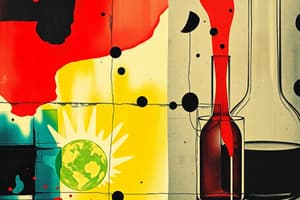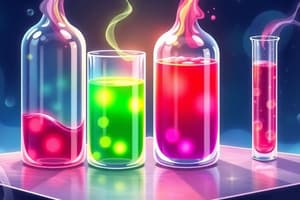Podcast
Questions and Answers
What color does turmeric paper turn in a basic solution?
What color does turmeric paper turn in a basic solution?
- Blue
- Green
- Yellow
- Red (correct)
What type of indicator is Litmus?
What type of indicator is Litmus?
- Olfactory
- Natural (correct)
- Synthetic
- Universal
What color does China rose indicator turn in acidic solutions?
What color does China rose indicator turn in acidic solutions?
- Green
- Blue
- Yellow
- Magenta (deep pink) (correct)
What is the color of phenolphthalein in acidic solution?
What is the color of phenolphthalein in acidic solution?
What is the color of turmeric?
What is the color of turmeric?
Which of the following is a common name for sodium chloride?
Which of the following is a common name for sodium chloride?
Our stomach produces which acid for digestion?
Our stomach produces which acid for digestion?
Which of the following has a sour taste due to the presence of acid?
Which of the following has a sour taste due to the presence of acid?
What happens to blue litmus paper when dipped in an acidic solution?
What happens to blue litmus paper when dipped in an acidic solution?
What is the color of China rose indicator?
What is the color of China rose indicator?
If a drop of baking soda solution turns red litmus paper to blue, what does that indicate?
If a drop of baking soda solution turns red litmus paper to blue, what does that indicate?
What type of dye is an indicator?
What type of dye is an indicator?
Which of the following is an example of an organic acid?
Which of the following is an example of an organic acid?
What substance is used in cooking food and is considered a salt?
What substance is used in cooking food and is considered a salt?
What color will red litmus paper turn when dipped in a basic solution?
What color will red litmus paper turn when dipped in a basic solution?
Which of the following is a natural indicator?
Which of the following is a natural indicator?
The acids present in plant materials and animals are called?
The acids present in plant materials and animals are called?
What color does turmeric turn when you scrub soap on a white shirt?
What color does turmeric turn when you scrub soap on a white shirt?
Phenolphthalein indicator gives what color in basic solution?
Phenolphthalein indicator gives what color in basic solution?
Flashcards
What is an indicator?
What is an indicator?
A 'dye' that changes color in acids/bases, indicating their nature.
Bases do what?
Bases do what?
Turns red litmus paper blue.
Acids do what?
Acids do what?
Turns blue litmus paper red.
Where does litmus come from?
Where does litmus come from?
Signup and view all the flashcards
What is China rose?
What is China rose?
Signup and view all the flashcards
What is turmeric indicator?
What is turmeric indicator?
Signup and view all the flashcards
What is Phenolphthalein?
What is Phenolphthalein?
Signup and view all the flashcards
Acidity's Taste?
Acidity's Taste?
Signup and view all the flashcards
What are organic acids?
What are organic acids?
Signup and view all the flashcards
Study Notes
- Acids, bases, and salts are vital chemical compounds.
- Examples of them being used include stomach acid (hydrochloric acid) for food digestion, baking soda (sodium hydrogen carbonate) in baking bread, and common salt (sodium chloride) as a cooking ingredient.
- Indicators are chemicals that show if a substance is an acid or a base by changing color.
- Litmus, China rose, and turmeric are natural indicators.
Indicators for Testing Acids and Bases
- An indicator is a dye that changes color in the presence of an acid or a base.
- Indicators reveal whether a tested substance is acidic or basic through color change.
- Acid-base indicators can be natural or synthetic.
Litmus
- Litmus, a natural dye from plants called lichens, is a common lab indicator.
- Litmus turns red in acidic solutions and blue in basic solutions.
- Blue litmus paper turns red when an acid is added.
- Red litmus paper turns blue when a base is added.
China Rose Indicator
- China rose, also known as Gudhal in Hindi, is a natural indicator.
- China rose indicator is a light pink coloured solution extracted from the red flowers of China rose plant with water.
- China rose indicator turns magenta (deep pink) when an acid is added.
- China rose indicator turns green when a base is added.
- Baking soda is a base because a drop of its solution turns China rose indicator green.
Turmeric as Indicator
- Turmeric is a natural indicator.
- Turmeric is a bright yellow powder obtained from a plant, called haldi in Hindi, is a yellow dye.
- Turmeric turns red in basic solutions and is often used as turmeric paper indicator.
Activity 2: Turmeric Paper Preparation
- Take a spoonful of turmeric powder
- Mix with a little water to make a paste
- Deposit the turmeric paste on a blotting paper (or filter paper) and dry it.
- Cut strips to create turmeric paper
Turmeric Paper
- Turmeric paper is yellow in color.
- Turmeric paper remains yellow in acid solutions.
- Bases will turn the yellow turmeric paper to red.
Phenolphthalein Indicator
- Phenolphthalein is a synthetic indicator.
- Phenolphthalein indicator is colorless in acidic solutions.
- Phenolphthalein indicator gives a pink color in basic solutions.
- Phenolphthalein indicator will change from pink to colorless when added in the solution of an acid in the solution of a base.
- In neutralization, a base cancels the effect of an acid seen with phenolphthalein.
Acids
- Lemons have a sour taste due to the acid within them.
- The sour taste of lemons is due to citric acid.
- Raw mangoes, grapes, lemon juice, curd, sour milk, vinegar, and tamarind get their sour taste from the acids these materials contain.
- Acids in plant and animal materials are called organic acids.
Organic Acids
- Organic acids are naturally occurring acids and are not harmful to consume.
- Formic acid is in insect stings.
- Acetic acid is found in vinegar.
- Lactic acid is in curd.
- Citric acid is in citrus fruits.
- Tartaric acid is in tamarind.
- Oxalic acid is present in spinach.
Mineral Acids
- Mineral acids are acids prepared from minerals.
- Mineral acids are also known as laboratory acides.
Studying That Suits You
Use AI to generate personalized quizzes and flashcards to suit your learning preferences.



